Final Report for FNC14-973
Project Information
The aspects of this project were many and included the seeding of cover crops, fabrication of a no-till planting aid (NTPA), rolling and crimping cover crops, and the planting of crops into rolled beds. While we had success with the NTPA, crop roller, and cover crop seeder, our ability to plant crops into rolled beds was limited due to three very wet seasons and a profusion of bindweed and grasses in rolled/crimped beds.
The NTPA was fabricated with a combination of on-farm implement parts (toolbar and shanks) and purchased items (toolbar clamps, coulters, fertilizer knives). Trialing of the NTPA showed that it works well in our silt/clay soils, cutting a 6 to 8 inch deep furrow that will allow for the planting of transplants.
After 1-1/2 seasons of searching for a 5 to 6 foot used grain drill with no luck it was decided that we would assemble a cover crop seeder with a new toolbar and four Cole Planter vegetable seeders. This arrangement required a double-pass to seed a bed with eight rows of cover crops. Several seeder and seed plate arrangements were tried, and the seeder worked adequately to produce a good stand of cover crops. This seeder system has the added benefit of being able to serve a dual purpose by also seeding cash crops.
A used flail mower was purchased as a part of the project to serve the dual purpose of either rolling down cover crops or flail mowing them. The unit purchased is heavy duty and complete with necessary belt guards and other safety feature desired for long-term farm use. The heavy roller on the unit worked well to roll/crimp the cover crops when the mower blades were not engaged. Vetch did require a second pass to mow off regrowth after the initial rolling.
The main aspect of this project, planting brassicas into rolled/crimped cover crops was not able to be accomplished over the three year period of this demonstration. In 2014 planting into the rolled beds was not able to be accomplished due to very wet conditions and a profusion of bindweed and grasses in the beds slated for brassica planting. In 2015 the project was suspended since the farm received almost 36 inches of rain between May 7 and July 20th. In 2016 rolled/crimped crops again saw a profusion of grasses that did not allow for brassica planting.
It appears that for our farm and perhaps our area of the country, it is difficult for rolled/crimped beds to keep weeds smothered during the 6 to 8 week period between rolldown in late-May and brassica planting in mid to late-July. This time period is prime for grass growth and this weed pressure is very strong in our grassland ecosystem.
The rolled cover crop beds used for summer tomato planting fared better. A comparison between a rolled/crimped bed and one where the cover crop was incorporated and beds hand-mulched showed the latter scenario to produce a significantly higher yielding crop of tomatoes (over 300% difference). These beds experienced less weed pressure issues as planting of tomatoes was completed about 2 weeks after crops were rolled/crimped.
With the help of Lincoln University Extension Agent Jim Pierce, we hosted two field days in 2014 and two in 2016. We also hosted a soils workshop farm tour as a part of the local Growing Growers farm apprentice program, and discussed the project work. We participated in a poster session at the 2015 Great Plains Growers Conference. In addition, updates have been posting on our farm blog www.fairsharenews.blogspot.com, and the results of our study were presented at the Kansas Rural Center Conference in November 2016.
Introduction:
Fair Share Farm is a diversified vegetable farm located in rural Clay County, Missouri that supplies a 140- member Community Supported Agriculture (CSA) in the Kansas City metro area. Rebecca Graff and Tom Ruggieri farm 5 acres using sustainable practices within the 260-acre Graff family farm. Crops include annual vegetables, strawberries, asparagus, herbs and a flock of 100 laying hens.
In 2004, Fair Share Farm received a Missouri Sustainable Agriculture Demonstration Award for “Transitioning Row Crop Fields to Organic Agriculture using Cover Crops.” We applied compost and organic amendments after testing the soil and began the seeding of cover crops. In the years since, we have seen a dramatic improvement in soil fertility and plant health. These results are evident in later soil testing and in the farm’s harvest records.
We have been working for eleven years to improve the quality of the soil on our farm and have seen significant improvements in fertility and soil structure as a result of our biological farming methods. To continue growing our operation, while relieving the physical burden on the farmers, implementation of more efficient farming methods is necessary.
Our interest in scaling-up production relates to our plans/recent construction of an on-farm food processing facility for fermented sauerkraut, kimchi and cucumber pickles. All major ingredients (cabbage, cucumbers, carrots, garlic, etc.) are to be grown on the farm.
Before we can grow, however, we face several obstacles. One is the time needed to hand-mulch crops. We have found that mulching of our fall brassicas is a necessity. Summer heat and drought require mulch to conserve moisture, minimize labor associated with weeding, and keep the soil cool. Growing our mulch in place using reduced tillage methods will save considerable time, energy and money, while adding fertility to the soil.
In addition, while we have been able to establish good stands of cover crops by hand broadcasting with a spin-seeder and harrowing with a tractor, this method is time consuming and yields inconsistent results when soil and weather conditions are not conducive to germination. A grain drill will allow for more precise seeding and better seed to soil contact, promoting more consistent germination and better stands.
We plan to trial the methods of “reduced tillage and cover cropping systems for organic vegetable production” developed by Dr. Ron Morse of Virginia Tech. Cover crops will be flattened using a roller/crimper, and then a no-till planting aid (NTPA) will be used to open a planting zone. Seeds will be sown with our Planet Jr. seeder pulled by the AC G and plants will be set with our existing water-wheel transplanter. We will focus on fall brassica production while trialing beds for other crops like summer tomatoes and direct seeded fall beets.
Dr. Morse has agreed to provide consultation for building the NTPA and the general implementation of the project. Reduced tillage trials will compare results to our current farming method which entails flail mowing and spading cover crops followed by cultivating and planting. Except for the beets, these production areas will be mulched with hay.
Cooperators
Research
2013
Sept-seed RV cover crops
2014
May-roll/crimp cover crops for trial areas and mow/spade/cultivate production area cover crops;
fabricate NTPA, purchase flail mower and drill seeder; trial seeder vs. broadcast seeding
June-plant summer tomatoes;
July-plant fall brassicas, direct seed beets
Sept-seed RV cover crop;
2015
Project was put on hold for 2015 due to farm receiving 36 inches of rain between May 5 and July 20
Sept-seed RV cover crop;
2016
May-roll/crimp cover crops for trial areas and mow/spade/cultivate production area cover crops;
June-plant summer tomatoes;
July-plant fall brassicas, direct seed beets
Rolling/Crimping Brassica Beds
On three occasions as a part of the project a rye/vetch cover crop was planted in September to be rolled down in late-May for subsequent planting of brassicas in July.
2014 The cover crop stand in May 2014 was excellent. In half of our main test area we used the roller on our flail mower to "roll down" the rye/vetch mix to create mulch that we could plant directly into with the NTPA. In the other half we mowed down the cover crop and spaded the crops into the soil for subsequent planting and hand-mulching. We rolled rye/vetch area on May 16 and it went well, creating a beautiful, spongy carpet of greenery. By June we observed the vetch growing back in the rolled down beds. Subsequent re-rolling did not kill the vetch and so it was mowed off and eventually died.
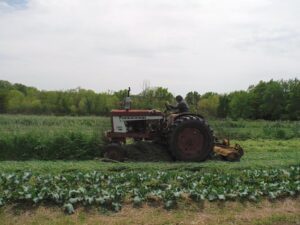
Rolling down the rye/vetch, May 2014
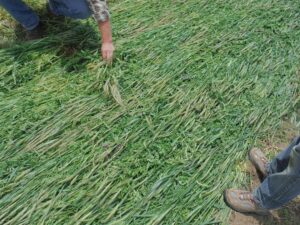 Freshly rolled and crimped rye/vetch
Freshly rolled and crimped rye/vetch
Unfortunately, we were suffering from a profusion of bind weed on our farm, and while the rye/vetch mulch held up well, the beds needed serious weeding in July, prior to any brassica planting in August. Several methods were trialed to see what might be an effective means of weeding.
A hand weeding of 33 ft of bed was completed by the farm crew on July 14th and required 5 man-hours. This showed hand weeding not to be cost effective, so an organic herbicide was tried (Ground Force citric acid based). As the photos show, the herbicide was effective; however, the bindweed grew back in subsequent weeks. At that point we decided to abandon the prospect of planting 2014 fall brassicas in these beds.
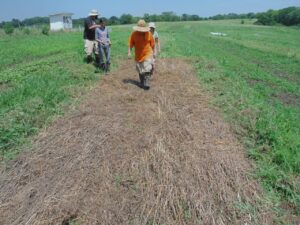 Hand weeding of roller/crimped bed
Hand weeding of roller/crimped bed
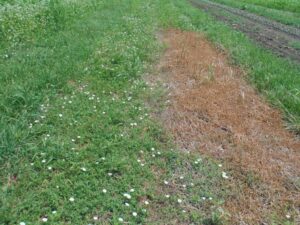 Roller/crimped bed showing bindweed and organic herbicide test patch
Roller/crimped bed showing bindweed and organic herbicide test patch
2015
The cover crop in 2015 grew well, however, extremely wet conditions on the farm in May-July precluded the possibility of properly rolling/crimping the rye/vetch. An attempt was made in June and resulted in rutting of the field. As the photo below shows, all of the cover crops were dead and dried back before an attempt of rolling could be completed. Work on the project was abandoned.
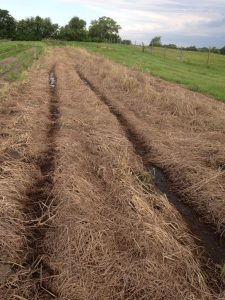 Rolling rye/vetch in June 2015
Rolling rye/vetch in June 2015
2016
The wet soils of 2015 did not allow for a good planting of fall cover crops. While the vetch that was seeded came in strong, there was very little rye that germinated, even after a second broadcast of seeds.
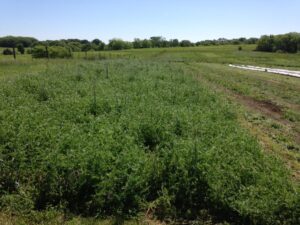 May 2016 mainly vetch cover crop
May 2016 mainly vetch cover crop
The mainly vetch cover crops were rolled down in May and later mowed off for subsequent planting in July. As with other years the grasses beneath the vetch proliferated in June and July, preventing us from planting a crop.
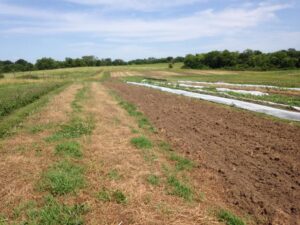 Rolled vetch with weed pressure, June 24th
Rolled vetch with weed pressure, June 24th
Summer Tomato Planting Trials
The beds described above are for our fall brassica plantings. We also ran a test bed for our mid-summer planting of tomatoes.
2014 Half of a 200 ft. bed was rolled/crimped and the other half was mowed and spaded. These beds proved problematic in June as they are located in a bit of a dip in the fields, and we received 10 inches of rain over the first 3 weeks of the month, making it difficult to do any planting or additional spading. We were unable to plant the middle portion of the bed due to wet conditions.
Over the course of a few weeks in late-June and early –July we were able to plant our “summer” tomatoes (determinates). The ground was very soupy and wet, and we were not able to achieve our objective of planting 50 tomatoes in the rolled part of the bed and 50 in the spaded portion. All of the tomatoes were caged after transplant. The rolled area of this bed did a good job of keeping down weeds and required less than 10 minutes of weeding with four people.
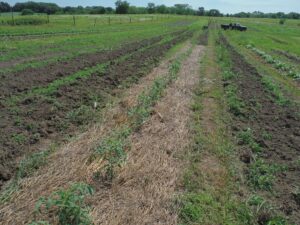 2014 Summer tomato plants in rolled/crimped beds. Mowed and spaded area at far end of bed
2014 Summer tomato plants in rolled/crimped beds. Mowed and spaded area at far end of bed
Unfortunately, harvest records for 2014 have been lost and data for this test is not available. As these beds were planted in very wet conditions at two different ends of a long bed, a comparison of results may not have been meaningful. The 2016 trial results are well documented and more comparative.
2016
Two side-by-side beds were used to trial the summer tomato planting in 2016. Except for the lack of rye in the cover crop, this trial went well and soil conditions were as good as can be hoped for. In one 100 foot bed the cover crop was mowed and spaded in twice before planting and hay mulching of the tomato plants. In the other bed the vetch was rolled down and later mowed before tomato planting. Both beds contained 42 plants.
The results show that the spaded and mulched bed performed over 300% better than the rolled/crimped bed. While both beds experienced a significant amount of blossom end rot during the first week or so of harvesting, the hay mulched bed recovered the quickest and produced the most firsts. In addition the hay mulched plants were a deeper green and were more vigorous in their growth and fruit-set.
|
Table 1 Tomato Trial 2016 |
|
||
|
Date |
Hay mulch |
Rolled |
|
|
8-Aug |
2 |
2 |
|
|
12-Aug |
14 |
16 |
|
|
16-Aug |
37 |
19 |
|
|
19-Aug |
33 |
9 |
|
|
23-Aug |
44 |
11 |
|
|
26-Aug |
38 |
12 |
|
|
30-Aug |
84 |
14 |
|
|
2-Sep |
26 |
9 |
|
|
9-Sep |
3 |
1 |
|
|
13-Sep |
8 |
1 |
|
|
16-Sep |
8 |
3 |
|
|
20-Sep |
6 |
2 |
|
|
4-Oct |
7 |
1 |
|
|
7-Oct |
10 |
2 |
|
|
11-Oct |
35 |
4 |
|
|
Total |
355 |
106 |
|
|
42 plants each bed |
|
||
|
2 foot spacing, caged |
|
||
|
Bella Rossa, hybrid determinate |
|||
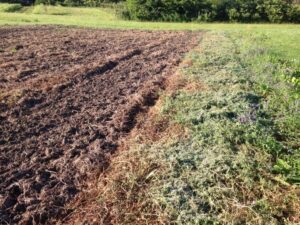 Mowed and spaded bed on left, rolled bed on right
Mowed and spaded bed on left, rolled bed on right
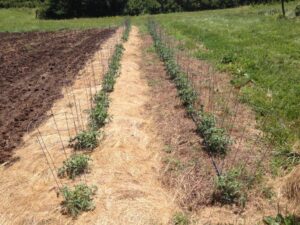 Hay mulch on left, rolled cover crop on right, June 28
Hay mulch on left, rolled cover crop on right, June 28
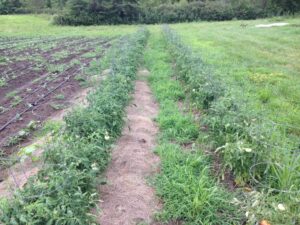 August 2
August 2
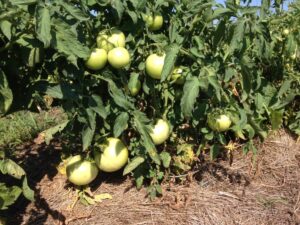 Fruit set on hay mulched tomatoes, August 16
Fruit set on hay mulched tomatoes, August 16
Fabrication of the No-Till Planting Aid (NTPA)
One of the more challenging parts of the project has been the fabrication of the NTPA. It was initially thought that we could put together this critical tool with existing farm implements, a couple purchases, and some bolts.
However, once we got our technical advisor Dr. Ron Morse of Virginia Tech on board we realized that we should invest in newer and heftier parts to help assure success. This led to the purchase of a new coulter and fertilizer knife.
While putting things together in May and June we then began realizing some of the more subtle limitations of the parts we had on hand. One was that what we thought was a square toolbar is actually a diamond bar, requiring us to shim these clamps. In addition we found that the plow shanks we were using were not long enough and would require bolting on an extension to allow enough room for the coulter and fertilizer knife to fit without overlapping.
Despite these issues, we were able to construct a very sturdy NTPA and trialed it in the rolled beds during the August 2014 field day. The implement worked well, cutting a clean furrow, however it showed areas where additional work was needed. In particular, the square clamps on the diamond toolbar did not hold as we would like, and excess metal from the shank that was at the level of the fertilizer knife was snagging field trash and affecting performance.
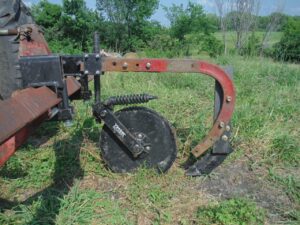 First NTPA fabrication
First NTPA fabrication
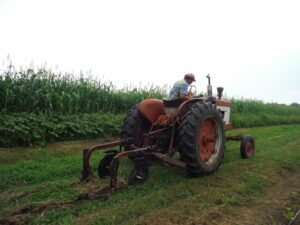 Trialing the NTPA in the rolled/crimped beds, August 2014
Trialing the NTPA in the rolled/crimped beds, August 2014
In 2016 we purchased diamond toolbar clamps and cut the excess metal off the shanks. While we were not able to plant the fall brassicas due to weed pressure in the rolled/crimped cover crop beds, we did trial the NTPA at our August 2016 field day. The unit worked better and did an excellent job of furrowing in our soils.
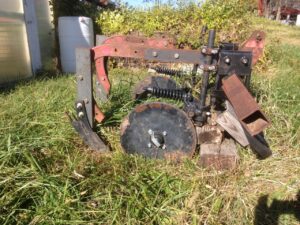 Final NTPA fabrication
Final NTPA fabrication
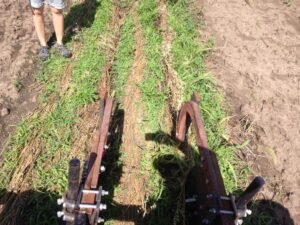 August 2016 Field Day NTPA trial
August 2016 Field Day NTPA trial
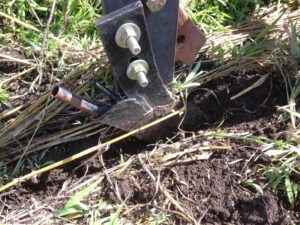 Fertilizer knife cutting furrow
Fertilizer knife cutting furrow
Grain Drill Purchase and Trialing
During the spring of 2014 we researched the purchase of a 6 foot wide grain drill to improve our cover crop seeding. We were unable to find a suitable used seeder. We were unable to do comparative trials of drill seeding vs. broadcast/harrow seeding as planned during 2014.
In past years we had done a small amount of cover crop seeding using our 3-row Planet Jr. vegetable seeder. Single seeded crops like buckwheat or tillage radish were easily seeded with this planter which was attached to our electric tractor (converted Allis-Chalmers G). We purchased 4 new Cole Planter seeders and had planned on using the electric tractor for this operation.
The new Cole seeders it turns out are significantly heavier than our old Planet Jr. seeders and would not fit onto the G toolbar, so a 3-point hitch toolbar was purchased and we used our Farmall 504 for seeding.
Past cover crop seeding was mainly accomplished by mixing our seeds and then using an Earthway broadcast seeder to spread the seeds by hand. Beds were then harrowed with either a spike-tooth harrow or a rotary harrow pulled by our Farmall. This method achieved very good results for us historically, but was inconsistent and required significant labor to cover 2+ acres/year. In addition it is a two-step process.
Spring 2016 Trial
The seeder was constructed and trialed two different ways. In the spring of 2016 the seeders were spread out along the length of the toolbar and offset, so that an up and back pass of a bed would seed 8 separate rows. In this trial two seeders contained a grain crop (oats) with associated seed plate, and the other two contained legume seeds (field peas).
While seeding worked well there were several difficulties with this setup:
- The offset was difficult to maintain (goal of 8 rows each 9 inches apart) and many rows overlapped, so that only 6 or so rows were present.
- Having to determine the best seed plate for each seed type became a complication and required extra work in setting up the seeder.
In April 2016 one set of beds was seeded with oats and field peas using the broadcast method and adjacent beds were seeded with the Cole seeder. For each trial area the growth in a 4 ft x 4 ft patch was cut and measured. Results are tabulated below and show the seeder to perform slightly better than the broadcast method.
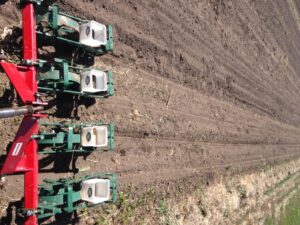 Cole Planter with offset
Cole Planter with offset
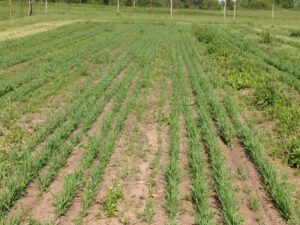 Spring 2016 seeding, oats and field peas
Spring 2016 seeding, oats and field peas
Table 2: Seeding Trial Spring 2016
|
Date |
Type |
Sample 1 (lb) |
Sample 2 (lb) |
Total |
Difference |
|
6/17/16 |
broadcast |
7.75 |
7.25 |
15.0 |
|
|
seeder |
7.25 |
9.75 |
17.0 |
+13% |
Summer 2016 Trials
Modifications to the seeder system were made in the summer. The seeders were moved to one side of the toolbar so that the up and back seeding would serve to seed half of the bed at a time. In addition, the seeds were mixed together. This mixing allowed us to use a single seed plate size for all 4 seeders. The plate was sized for the larger of the two seeds so that a total of approximately 2 lb/1,000 sq ft would be achieved. This rate was also the rate used by the broadcast seeder.
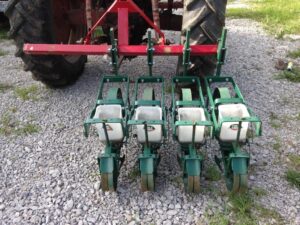 Seeders set to one side
Seeders set to one side
The test area was seeded with sorghum sudan grass and cowpeas on July 24. Germination was slow, as the seeding was completed during a hot/dry spell. Because of this weed pressure was experienced before the crops germinated in earnest. As with the spring trial, growth from two separate 4 ft x 4 ft areas was taken prior to mowing. Table 3 shows that the broadcast/harrowed area performed better than the seeded area. We believe this is due in part to the extra harrowing that this test patch received.
Table 3: Seeding Trial Summer 2016
|
Date |
Type |
Sample 1 (lb) |
Sample 2 (lb) |
Total |
Difference |
|
9/23/16 |
broadcast |
11.25 |
9.25 |
20.0 |
+40% |
|
seeder |
10.0 |
4.75 |
14.75 |
We continued to use the seeder for the planting of summer and late-summer cover crops. The system worked well and produced some excellent stands of both sorghum sudan grass/sunn hemp as well as oats and field peas.
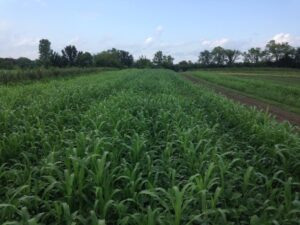
Flail Mower Purchase
For over a year we researched the purchase of a used 6 foot wide flail mower to replace our current model which is lacking in safety features. In March 2015 we were able to purchase an Alamo Mott 6 foot wide flail mower. This unit has worked as advertised, doing an excellent job of flail mowing cover crops and serving to adequately roll down cover crops.
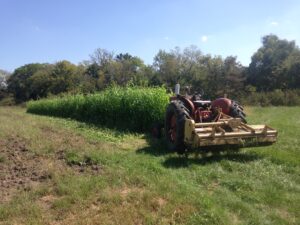 Flail mower
Flail mower
Impact of Results/Outcomes
Accomplishments of the project are described in the above section.
Educational & Outreach Activities
Participation Summary:
With the help of Lincoln University Extension Agent Jim Pierce, we hosted two field days in 2014 and two in 2016.
We also hosted a soils workshop farm tour as a part of the local Growing Growers farm apprentice program in 2014, and discussed the project work.
We participated in a poster session at the 2015 Great Plains Growers Conference.
In addition, updates have been posting on our farm blog www.fairsharenews.blogspot.com.
The results of our study were presented at the Kansas Rural Center Conference in November 2016.
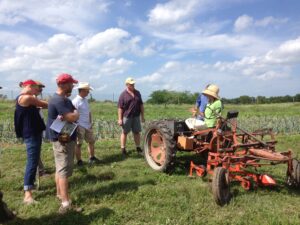
2016 field day and electric tractor demonstration
Project Outcomes
Potential Contributions
No-Till Roller Crimper Conclusions
- Good stands of cover crops are easily rolled/crimped with flail mower roller
- Prime grass growth and weed pressure is in June/July when the rolled down beds are sitting idle. Weed pressure is high in late-July when no-till planting is planned.
- Rolling/crimping is hard to implement in wet periods
- Hand weeding and organic herbicides are not effective in controlling weeds in rolled down crops
No-Till Tomato Trial
- Roller/crimped crops keep down weeds during early growth stage. Tomatoes are typically planted within about 2 weeks of crops being rolled down.
- Spaded and hay mulched beds produced 3X the yield of rolled/crimped beds in 2016. We believe this is because of better incorporation of the cover crops and subsequent release of nutrients.
NTPA Trial
- Farm hacking rather than buying new toolbar and implement parts can save money but takes more time
- The NTPA is a great tool for furrowing in no-till situations
- May use during wet periods to minimize need to spade/till before planting
Seeder Trials
- Vegetable seeder can be used to seed cover crops
- Combine two seed types and use seeder hole that is best for largest seed
- Difficult to get 8 evenly spaced rows with 4 row seeder/2 pass
- Harrowing can be just as effective if broadcast, harrowed and germinated properly (more physical effort)
Future Recommendations
Based on the results of our study we do not anticipate rolling down cover crops for fall planting and do not recommend it for organic farms in areas where grasses naturally predominate.
We recommend further evaluation of the use of a 4-row vegetable seeder for the seeding of cover crops. This system is flexible for use by small farms by helping to limit the amount of equipment necessary, as the seeder can serve a dual purpose.